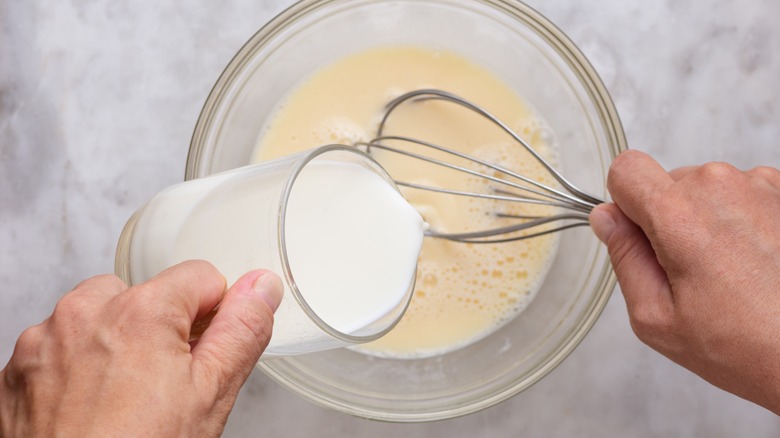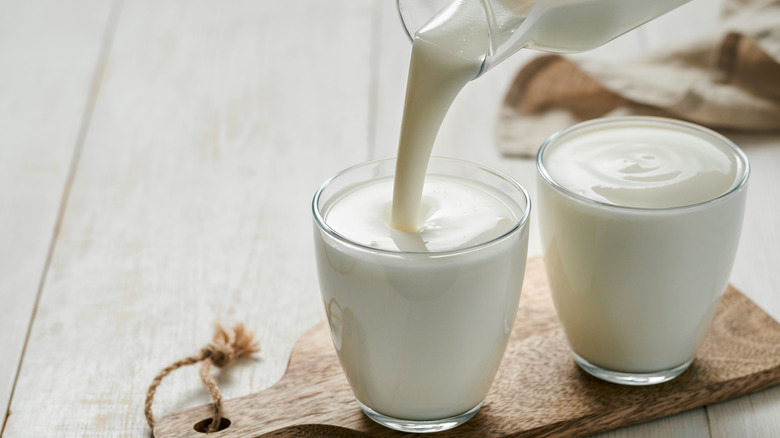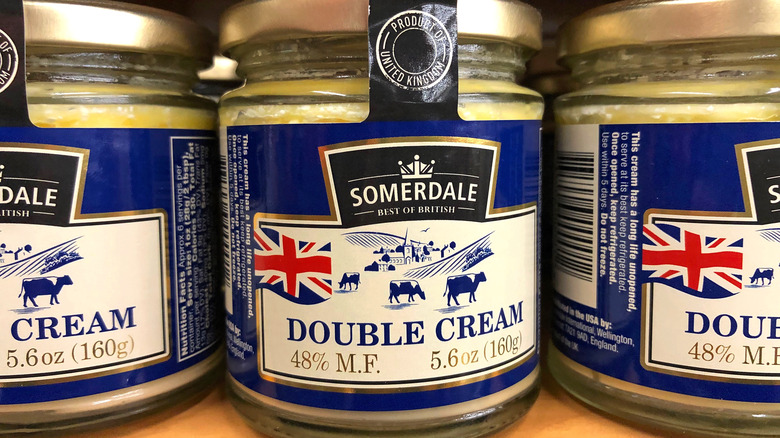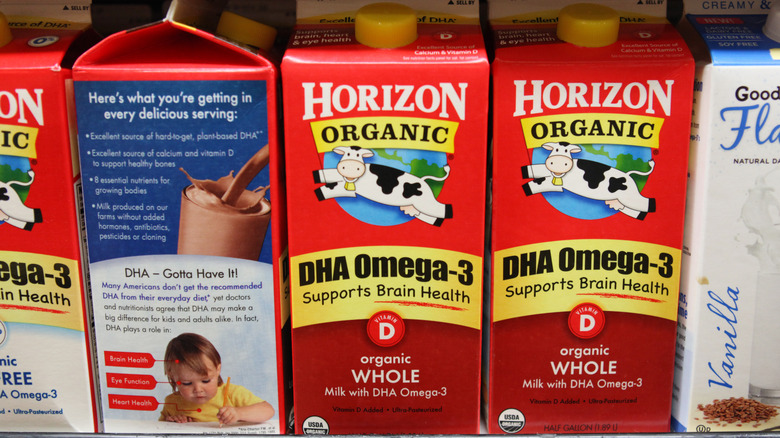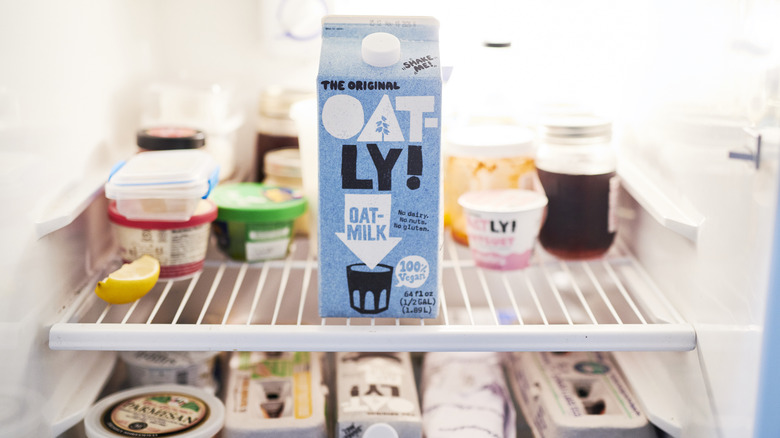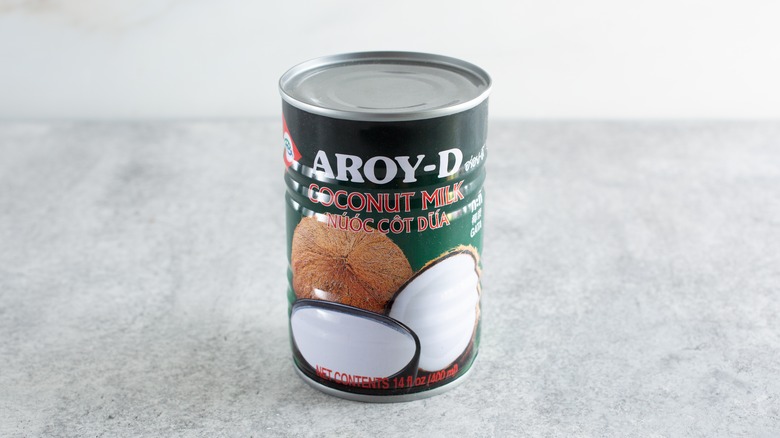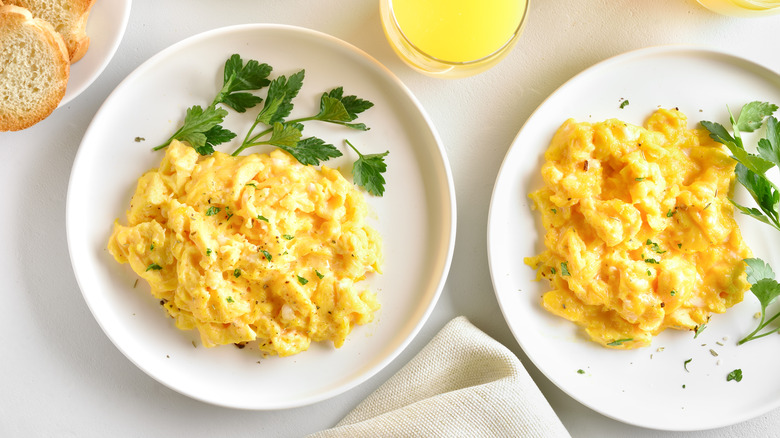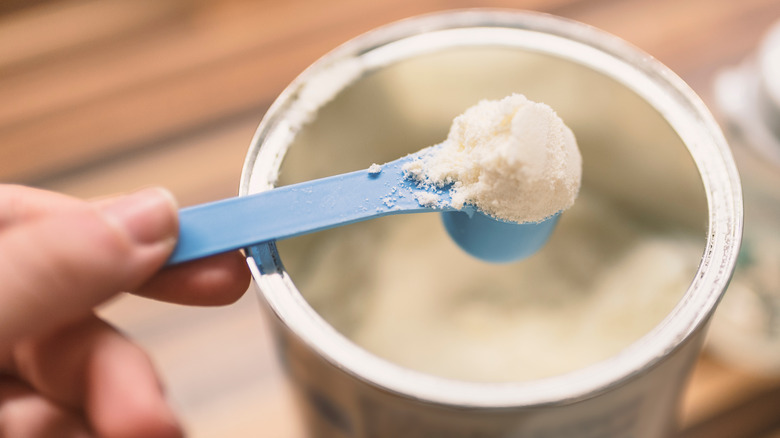Tips You Need When Cooking With Milk
Whether cooking with cow's milk or plant-based alternatives, milk is a common ingredient in many recipes. The term milk can also mean something different to different people: homogenized milk, raw milk, coconut milk, rice milk, almond milk, sour milk, etc. So, we compiled some tips you'll want to consider when cooking with milk, not only because dairy and other plant-based kinds of milk are a rich and tasty addition, but they also present some challenges. Which milk varieties are best for sauces versus baked goods? How should we handle recipes where the heat might be too high for dairy? Which plant-based milk alternative is best for zucchini bread?
In addition to finding answers to some of milk's most pressing questions, the benefits of knowing when and how to use the right type of milk are a game-changer for your palate. We also found which creamy varieties you'll want to swap out for tastier results and why milk sold in grocery stores today makes cooking with milk easier than it was for previous generations. And, it turns out, organic milk might make up the price difference once you hear how it's a secret weapon against food waste.
Homogenized milk makes cooking with dairy easier
Today's milk is treated much differently than the milk of previous generations. Almost all milk you find in a U.S. grocery store is homogenized — and it is ideal for home cooks. Homogenization is a process that reduces large fat molecules to prevent cream from rising to the top — not to be confused with the process of heating milk to kill any potential bacteria called pasteurization. Both methods are common regardless if you're buying whole, skim, or nonfat percentages. While debates have raged about the need for pasteurization in recent decades, homogenization is less about safety and more about uniform dairy tailored to consumer preferences.
HuffPost reports farmers can create a consistent, smooth product without any additives thanks to homogenization and remove fat content to make skim or 2% varieties. As a bonus, the news site says this treated liquid can travel longer distances to retailers without spoiling. Home cooks benefit from a longer shelf-life and a stable product without having to skim away cream rising to the top. Want to make creamy tomato soup or homemade ice cream? You know exactly what you're getting with every drop. Grandma never had it so good.
Save leftover milk for cooking
Wasting perfectly good food in the fridge is a huge problem in the United States. Food waste costs an estimated $1,500 each year for a family of four, and that number is just the tipping point (via NRDC). To make matters worse, the Natural Resources Defense Council found two-thirds of food that is thrown away in major cities in the U.S. are perfectly edible. Have leftover milk at the end of the week? Don't be so fast to discount this dairy staple. Dumping out leftover milk could be costing you money and opportunities for other uses in the kitchen.
Fine Dining Lovers says dairy represents 17% of all food waste in the U.S., so the site recommends storing milk deep in the fridge — not in the door — and freezing any if you're worried about spoilage. The site also advises using leftover milk to make rich, dairy-heavy béchamel, bread, custard, or cheese, such as Indian paneer.
You can also turn milk into buttermilk using distilled vinegar or lemon with any type of milk, including almond or coconut alternatives. Although homemade buttermilk will be more curdled than commercial, the flavor is ideal for cooking fried chicken or making biscuits.
Sour milk is ideal for baking (and a waste-free kitchen)
The sharp smell from a milk carton is a clear indicator that you won't want to add any to your cereal or coffee. The good news is you don't have to waste milk with a bit of funk anymore: Spoiled milk is still perfect for baking. You might be thinking, but isn't the bad smell an indicator that it'll make me sick? NPR reports the added acidity in pasteurized sour milk detours harmful microbes that make us sick, so a bit of sour can avoid the drain and go into homemade baked goods. The news site spoke with Dana Gunders of the Natural Resources Defense Council, who uses sour milk as a substitute for buttermilk. The result? Extra fluffy pancakes. Wait a bit too long, and see chunks and clots? Time to toss that sour milk.
Homesteaders — and likely your older relatives — are familiar with the benefits of using sour raw milk for baking. Homesteading Family says raw milk left to sour at room temperature for four to five days is called clabbered milk, which has an acidity like buttermilk. This sour raw milk will have a sweet, sour taste perfect for zucchini bread, yeast rolls, or a meat marinade. Is raw risky? Sure, but so is pasteurized milk, an undercooked egg, kombucha, raw spinach, and sushi, and many states have legalized raw milk, including recent additions like Hawaii and Georgia.
Substitute rich double cream for heavy cream
Pastry chefs know the value of heavy cream, but what about its cousin, double cream, from across the Atlantic? What's Cooking America explains that double cream contains 48% butterfat (around 10% more on average than heavy cream) and is only second in fat content to clotted cream (coming in at a whopping 60% fat). Its thickness makes double cream perfect for whipping or making homemade butter. All the delicious double cream (aka fat) also prevents curdling when cooking soups or making an acidic sauce.
You might be thinking, do we really need a dairy even richer than full-bodied, heavy cream? Well, the answer depends on how you use it. Do you want to make homemade whipped cream with fluffy peaks reaching toward your taste buds with every spoonful? Does the sound of tender ground beef or moist fried chicken that stays juicy with each bite make your mouth water? What about pouring a thick double cream over pie instead of hurting sensitive teeth with ice cream? The real question of whether to replace heavy cream with double cream should be, why not?
Prevent milk from curdling when cooking
While sour milk might make for puffier pastries, curdled milk is less than appetizing for thick sauces or hot coffee when cooking. Curdling is when the proteins in milk clump together due to acidity or heat changing the pH of the liquid. Clumps in smooth tomato sauce might be frustrating, but on the bright side, curdling could result in some delicious cheese. The texture of cottage cheese has a time and a place, but cooks should be aware of how to avoid curdled milk when necessary.
Taste Kitchen & Table recommends avoiding high heat or boiling milk and adding flour or starch to counteract dairy mixing with acidic ingredients such as tomatoes, wine, and lemon juice. Allrecipes says heavy cream is less likely to curdle at high heat, but be careful with high acidity, and add sour cream at the end of a recipe because it's not as fatty as you might think (at least, when it comes to cooking!). Allrecipes also finds that adding warm sauce or broth to sour cream or yogurt before adding it to a saucepan or piping-hot dish will help avoid tell-tale chunks.
How to scald milk for baking
Certain recipes like making yogurt or bread call for scalded milk, but you don't want to end up with burnt milk. If high heat can cause curdling, then the whole idea of scalding milk can be intimidating. But why scald in the first place? Most milk today is already heated through pasteurization for food safety reasons.
The team at MasterClass says scalded milk leaves the good bacteria in ingredients like yogurt and eliminates naturally occurring whey proteins that prevent yeast from rising, a helpful step for bread recipes. The site's award-winning pastry chef says scalded milk should reach 180 F, whether on the stove or in a microwave-safe bowl. Before mixing, milk should also cool to room temperature to avoid killing the live yeast. Don't have a food thermometer handy? Food Network explains you can heat the milk until it bubbles around the pan edges (but not a full boil), then immediately remove the pot from the heat. Paying careful attention should do the trick.
Infusing milk with spices or lemon zest will have the added benefit of bringing out the flavor needed for homemade ice cream. Spices like cinnamon can also save burnt milk by masking the unfortunate taste and smell of overcooked dairy.
Organic milk has longer shelf life
People buy organic for many reasons. Some shoppers want healthier options by skipping pesticides, growth hormones, or what the Mayo Clinic calls "sewage sludge" used on their food. Some chefs are looking to support local organic farmers. Others might be asking, what does organic even mean? In the case of milk, organic can mean a longer shelf life.
The New York Times finds most organic milk brands sterilize milk at higher temperatures than regular pasteurized milk (280 F versus 161 F), allowing the liquid to keep for months even at room temperature (if unopened). A longer shelf life might make up for the additional cost if you have trouble using a full carton before it turns (or if the idea of sour milk makes your stomach do the turning). The higher temperature also results in sweeter milk along with a creamier texture (via Huffpost). Buying organic might not be necessary for all of your groceries, especially for the budget-conscious. Still, organic milk is a win for people looking to eliminate food waste and potential toxins from their food.
Oat milk is the best plant-based milk for baking
Not all milk lovers can stomach dairy from a cow. If you abstain from milk made by animals for health or socially conscious reasons, we're happy to say that non-dairy milk alternatives have come a long way in recent years. Plant-based milk might even be healthier than cow milk. But, if different milk varieties cook differently, which milk alternatives are good for cooking?
According to Laura Page of MarthaStewart.com, the best oat milk is from a brand with minimal ingredients. Also, make sure the oat milk is gluten-free, which, surprisingly, it's not a given for all oat milk. The site prefers oat milk for its toasted flavor, which compliments baked goods such as cornbread, chocolate cupcakes, and berry muffins. Martha Stewart's team also spoke with a founder of Forager Project, who believes shaking oak milk best replicates the smooth texture of cow's milk. Finally, the oat flavor also pairs well with savory soups or mashed potatoes — just make sure to buy a sugar-free version.
Coconut milk is as versatile as dairy
Rich and sweet coconut milk is a staple in pantries for chefs across the globe. Coconuts might have become a popular plant-based milk substitute in the U.S., but many of those beverages next to the soy and almond milk aren't real coconut milk. Eater says those brands of beverages have only "a vague trace" of coconut and aren't a substitute for the flavorful, thick Thai-style canned coconut milk — ideally, made without sweeteners or additives.
Chef Pailin Chongchitnant explains on her popular cooking channel Hot Thai Kitchen that the thick meat is scraped from the inside of the coconut and strained, and if an industrial process, it will be blended and canned. This shelf-stable dairy alternative is what we're talking about as an excellent choice for cooking with milk.
Thick coconut milk must first be stirred or shaken to ensure a correct ratio of coconut cream to liquid. An obvious choice for cooking with coconut milk is in a flavorful coconut curry, such as Khao Soi, or desserts like tres leches cake and custards. Coconut milk can also replace dairy and other milk alternatives in seafood dishes, sauces, marinades, and baked goods. Don't sleep on this all-purpose nondairy milk.
Skip the milk for creamier scrambled eggs
Fluffy and light scrambled eggs can be the ideal way to start (or end) your day. Some of us have grown up thinking adding a bit of creamy milk to eggs is the best way to achieve fluff. No shade to your parents, but you'd be wrong. Adding liquid like milk to scrambled eggs makes the mixture easier to overcook and the flavor diluted (via Southern Living). Overcooked eggs turn into a rubbery, dense mess — the antithesis of what you were trying to achieve.
There are plenty of ways to make light, rich scrambled eggs without the milk. Instead of a spatula, you can stir with chopsticks, creating a smaller curd in the eggs. Add some garlic powder to amp up the flavor even more. But by far, the best addition to scrambled eggs is butter. Adding in cold or frozen butter matches the temperature of the eggs and coats the proteins with fat for the perfect pairing cooked over low heat. Plus, take advice from Anthony Bourdain and beat the eggs right before adding it to the pan. And if you have the time, cook French-style scrambled eggs over super low heat (and plenty of butter) for a creamier, velvety version. Isn't that really what you wanted in the first place?
Powdered milk is a chef's secret ingredient
Powdered milk might sound like an item for babies, disaster preparedness, bodybuilding, or only the most frugal-minded home cooks. Yes, shelf-stable powdered milk could be beloved for all of those reasons, and it's exactly what you might expect: a dry form of milk you can buy in bulk and mix with water as needed. But, chefs in the know understand the powerful flavor of these concentrated milk flakes.
As Christina Tosi of Milk Bar fame told Epicurious, powdered milk adds a robust punch to the chocolate in a pie, chewiness of cookies, silkiness of ice cream, or really, any baked good you want to make more luxurious. Tosi recommends experimenting by mixing a tablespoon of milk powder with the dry ingredients in your next dessert. Another tip is from cookbook author Ramin Ganeshram, who explains to Epicurious that milk powder adds proteins and sugars without additional liquid, helping dough rise higher and become more tender.
More of a fan of savory flavors? Food52 says adding powdered milk to soups, sauces, and gravies is a creamier alternative to flour when thickening. Of course, you can always use powdered milk for drinking, whether in a tall glass by itself or as a hot chocolate.


